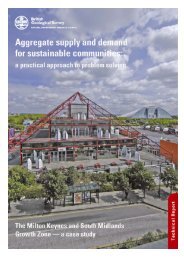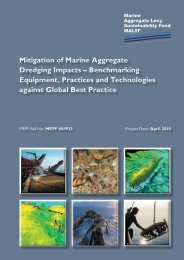creating environmental improvements through biodiversity
creating environmental improvements through biodiversity
creating environmental improvements through biodiversity
Create successful ePaper yourself
Turn your PDF publications into a flip-book with our unique Google optimized e-Paper software.
Recommendation that a systematic methodology be developed to monitor <strong>biodiversity</strong> on quarrying sites (at<br />
all stages), and possibly that a national data collection scheme be implemented<br />
Impacts (Actual):<br />
The report illustrates that restoration of natural habitats to quarry sites can have beneficial effects for flood<br />
management as well as for <strong>biodiversity</strong>.<br />
Impacts (Potential) / Potential Expansion:<br />
Recommendations are made for a more co-ordinated approach to restoration for <strong>biodiversity</strong> across<br />
the quarrying industry. Strong grounds are provided for this, highlighting the current paucity of ecological<br />
information on quarry sites. A more co-ordinated approach would facilitate reasoned implementation of<br />
future restorations, and an increased resource of ecological information could help to guide and support<br />
future restorations for <strong>biodiversity</strong>.<br />
Dissemination:<br />
Information on dissemination of this report could not be obtained.<br />
RECLAMATION PLANNING IN HARD ROCK QUARRIES: A GUIDE TO<br />
GOOD PRACTICE (MIRO SAMP, DCLG, UNIVERSITY OF SHEFFIELD, EDGE<br />
CONSULTANTS)<br />
J. C. Cripps, V. Roubos (Department of Civil and Structural Engineering, University of Sheffield) D. Hughes, M.<br />
Burton, H. Crowther, A .Nolan, C. Travis (Environmental Consultancy University of Sheffield) I. M. Nettleton,<br />
M. A. Czerewko, D. Tonks (Edge Consultants UK Ltd.)<br />
March 2004<br />
Sustainable Aggregates Creating Environmental Improvements <strong>through</strong> Biodiversity<br />
Project Type: Guidelines<br />
Site: Observations at 25 English hard rock quarries<br />
Project Aim: To provide guidance on an appropriate methodology for the planning of reclamation,<br />
including the formation of new landscape features, such as slopes and faces, and associated ecologies<br />
Main Methods: Literature search, site investigations, consultations (steering group and advisory<br />
correspondence group)<br />
Output:<br />
Guidance on restoration in hard rock quarries:<br />
Outline of relevant planning policies and legislation<br />
Outline of European and UK legislation on landscape and <strong>biodiversity</strong><br />
Flow diagram outlining the main stages normally required to plan and develop a restoration scheme,<br />
emphasising the need for a staged approach<br />
Stress on the need for scoping, plus data input and expert consultations at different stages, especially where a<br />
quarry falls within or close to <strong>environmental</strong>ly sensitive landscape and wildlife resources<br />
Tables of information sources (including NGOs, statutory conservation bodies, specialist local species<br />
groups), and types of information to gather (including habitats and species)<br />
Discussion of the value of natural regeneration of hard rock quarries, depending on required timescales, site<br />
conditions etc. – that habitat creation techniques may be required to assist natural regeneration, but that<br />
valuable habitats can sometimes develop naturally<br />
Discussion of landfill sites, including that ‘the consideration of nature conservation interests and the potential<br />
for wildlife enhancement <strong>through</strong> habitat creation at landfill sites is also the subject of guidance published by<br />
55

















